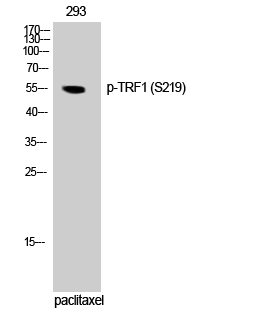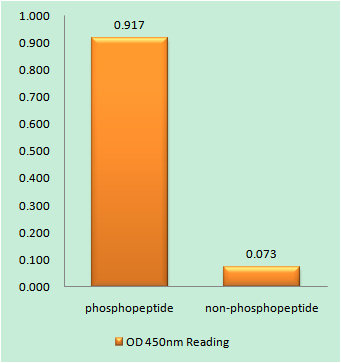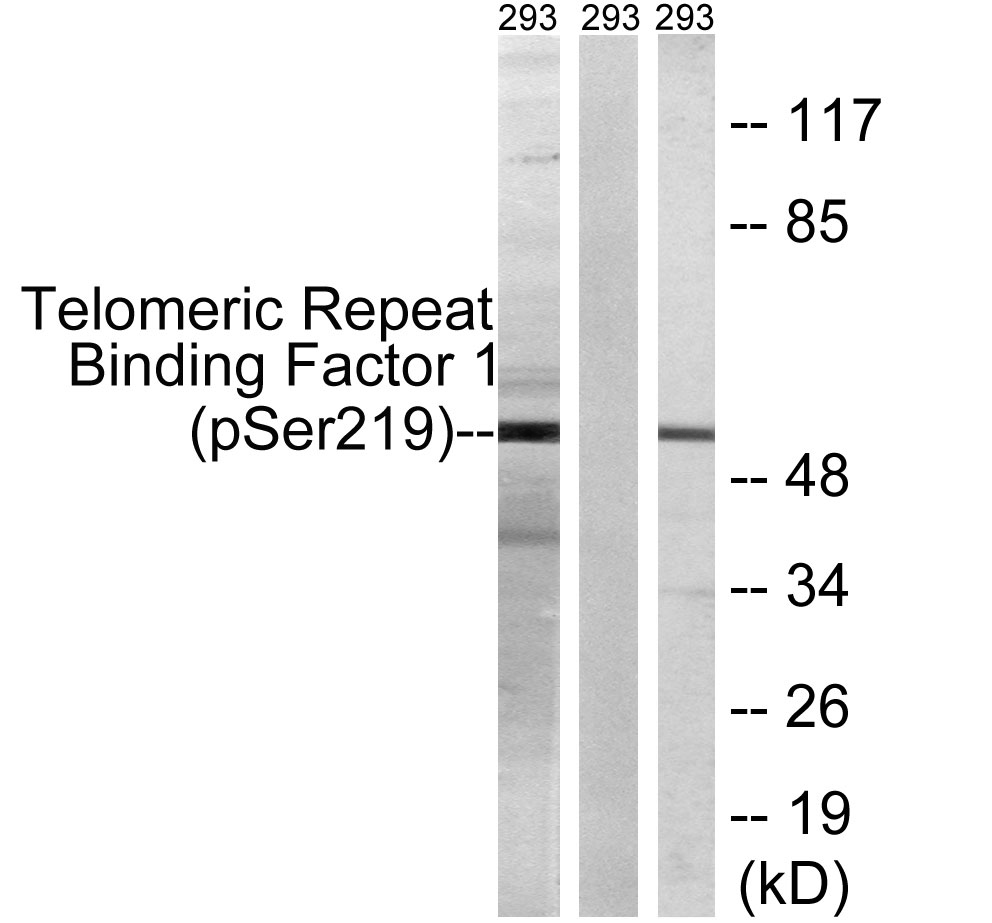TRF1 (phospho Ser219) Polyclonal Antibody
- Catalog No.:YP0400
- Applications:WB;ELISA
- Reactivity:Human;Mouse
- Target:
- TERF1
- Gene Name:
- TERF1
- Protein Name:
- Telomeric repeat-binding factor 1
- Human Gene Id:
- 7013
- Human Swiss Prot No:
- P54274
- Mouse Gene Id:
- 21749
- Mouse Swiss Prot No:
- P70371
- Immunogen:
- The antiserum was produced against synthesized peptide derived from human Telomeric Repeat Binding Factor 1 around the phosphorylation site of Ser219. AA range:185-234
- Specificity:
- Phospho-TRF1 (S219) Polyclonal Antibody detects endogenous levels of TRF1 protein only when phosphorylated at S219.
- Formulation:
- Liquid in PBS containing 50% glycerol, 0.5% BSA and 0.02% sodium azide.
- Source:
- Polyclonal, Rabbit,IgG
- Dilution:
- WB 1:500 - 1:2000. ELISA: 1:5000. Not yet tested in other applications.
- Purification:
- The antibody was affinity-purified from rabbit antiserum by affinity-chromatography using epitope-specific immunogen.
- Concentration:
- 1 mg/ml
- Storage Stability:
- -15°C to -25°C/1 year(Do not lower than -25°C)
- Other Name:
- TERF1;PIN2;TRBF1;TRF;TRF1;Telomeric repeat-binding factor 1;NIMA-interacting protein 2;TTAGGG repeat-binding factor 1;Telomeric protein Pin2/TRF1
- Observed Band(KD):
- 55kD
- Background:
- This gene encodes a telomere specific protein which is a component of the telomere nucleoprotein complex. This protein is present at telomeres throughout the cell cycle and functions as an inhibitor of telomerase, acting in cis to limit the elongation of individual chromosome ends. The protein structure contains a C-terminal Myb motif, a dimerization domain near its N-terminus and an acidic N-terminus. Two transcripts of this gene are alternatively spliced products. [provided by RefSeq, Jul 2008],
- Function:
- domain:The acidic N-terminal domain binds to the ankyrin repeats of TNKS1 and TNKS2. The C-terminal domain binds microtubules.,function:Binds the telomeric double-stranded TTAGGG repeat and negatively regulates telomere length. Involved in the regulation of the mitotic spindle. Component of the shelterin complex (telosome) that is involved in the regulation of telomere length and protection. Shelterin associates with arrays of double-stranded TTAGGG repeats added by telomerase and protects chromosome ends; without its protective activity, telomeres are no longer hidden from the DNA damage surveillance and chromosome ends are inappropriately processed by DNA repair pathways.,induction:Pin2 expression is tightly regulated during the cell cycle; levels are low in G1 and S phase and increase during G2 phase and mitosis.,PTM:ADP-ribosylation by TNKS1 or TNKS2 diminishes its ability to bind to
- Subcellular Location:
- Nucleus. Cytoplasm, cytoskeleton, spindle. Chromosome, telomere. Colocalizes with telomeric DNA in interphase and prophase cells. Telomeric localization decreases in metaphase, anaphase and telophase. Associates with the mitotic spindle.
- Expression:
- Highly expressed and ubiquitous. Isoform Pin2 predominates.
- June 19-2018
- WESTERN IMMUNOBLOTTING PROTOCOL
- June 19-2018
- IMMUNOHISTOCHEMISTRY-PARAFFIN PROTOCOL
- June 19-2018
- IMMUNOFLUORESCENCE PROTOCOL
- September 08-2020
- FLOW-CYTOMEYRT-PROTOCOL
- May 20-2022
- Cell-Based ELISA│解您多样本WB检测之困扰
- July 13-2018
- CELL-BASED-ELISA-PROTOCOL-FOR-ACETYL-PROTEIN
- July 13-2018
- CELL-BASED-ELISA-PROTOCOL-FOR-PHOSPHO-PROTEIN
- July 13-2018
- Antibody-FAQs
- Products Images

- Western Blot analysis of 293 cells using Phospho-TRF1 (S219) Polyclonal Antibody cells nucleus extracted by Minute TM Cytoplasmic and Nuclear Fractionation kit (SC-003,Inventbiotech,MN,USA).

- Enzyme-Linked Immunosorbent Assay (Phospho-ELISA) for Immunogen Phosphopeptide (Phospho-left) and Non-Phosphopeptide (Phospho-right), using Telomeric Repeat Binding Factor 1 (Phospho-Ser219) Antibody

- Western blot analysis of lysates from 293 cells treated with paclitaxel 1uM 24h, using Telomeric Repeat Binding Factor 1 (Phospho-Ser219) Antibody. The lane on the right is blocked with the phospho peptide.


